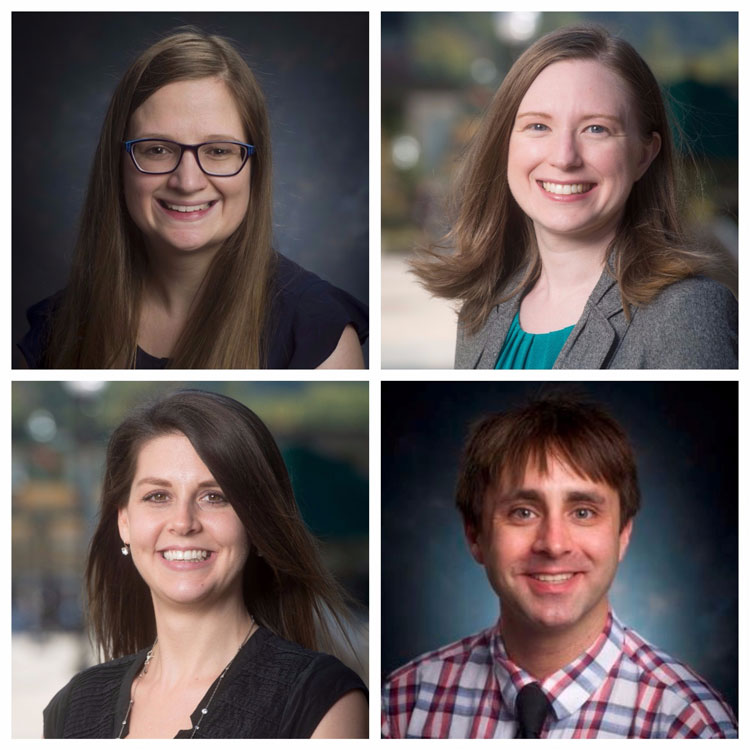In exchange for biomedical research in vision science, the National Institutes of Health are repaying the student debt of four faculty members at the UAB School of Optometry.
The faculty members who have contracts with the NIH Loan Repayment Programs, established by Congress to recruit and retain highly qualified health professionals into biomedical or biobehavioral research careers, are: Anna Ablamowicz, O.D., clinical assistant professor; Stephanie Cox, O.D., clinical assistant professor; Andrew Pucker, O.D., Ph.D., assistant professor; and Jillian Ziemanski, O.D., M.S., clinical assistant professor.
The programs repay up to $35,000 annually of a researcher’s qualified educational debt in return for a commitment to engage in NIH mission-relevant research.
Ablamowicz has had a contract with the program since 2014. In exchange for the assistance with her student debt, she investigates causes and consequences of dry eye disease—a condition that affects millions of people worldwide, isn’t completely understood and is therefore widely underdiagnosed and undermanaged, she says.
“For me personally, through my research and clinical endeavors, I am committed to preserving human sight and improving patient care,” Ablamowicz says. “As an NIH Loan Repayment Program recipient, I have been able to focus on developing as an adept clinician scientist and researcher by obtaining a Ph.D. in Vision Science. Receiving this award has allowed me to remain in a university setting as part-time clinical faculty and given me the opportunity to build a solid research foundation for my career.”
Cox has received more than $100,000 in loan repayments from the NIH, which has allowed her to pursue a research career without worrying about taking on more loans, she says. Cox uses functional magnetic resonance imaging to better understand the processing of ocular surface sensations and the lacrimal reflex arc.
“I am investigating possible central mechanisms of dry eye disease, which may help us to better understand why we have patients who have symptoms of dry eye but no clinical signs of dry eye,” she says.
During the six years Pucker has received funding from the Loan Repayment Program, he has focused on determining if mechanically induced signaling plays a role in myopia development. Specifically, Pucker hypothesizes that the nearsighted eye places stress on the ciliary muscle, or the focusing muscle, which triggers specific biochemical pathways that lead to muscular hypertrophy, altered eye shape and accelerated axial elongation.
“Overall, it is hoped that understanding the potential mechanisms leading to myopia development and understanding how the ciliary muscle is related to myopia will lead to targeted treatment or prevention strategies for myopia and other ciliary muscle-related conditions like glaucoma and accommodative dysfunction.”
Pucker says obtaining the support from the Loan Repayment Program allowed him to pursue a Ph.D. in Vision Science after earning his O.D. degree from The Ohio State University — “a feat that would not have been financially practical because at the completion of my O.D., I was accruing more than $1,000 per month in interest and was expected to make over $2,000 per month in student loan payments,” he says. “Essentially, the Loan Repayment Program freed me from the need to practice full-time, and it has allowed me to develop into the clinician-scientist and educator that I am today.”
Ziemanksi has received $105,000 toward her student loans. Her contract has allowed her to work on two projects. Her first project evaluates the types of lipids produced from human meibomian gland epithelial cells after treatment with varying ratios of omega-6 fatty acids and omega-3 fatty acids. She is also looking at the lipids produced after exposure to Accutane, a medication known to damage the meibomian glands, and investigating whether the omega-6:omega-3 ratios prevent or potentiate the effects of Accutane.
Her second project evaluates whether the complement system, which is a part of the immune system, is involved in the disease mechanism of Sjogren's syndrome, a systemic autoimmune disease known to cause severe dry eye and dry mouth.
Ziemanski will recruit participants and collect tears and cells from their ocular surface to evaluate complement's involvement in the disease.
“Having a clinical degree, whether it's an O.D., M.D., D.D.S., etc., allows clinicians to provide care based on the field's current level of knowledge,” Ziemanski says. “Without active research programs and productive scientists, all forms of healthcare remain stagnant.”
She says there are a number of barriers that dissuade clinicians from wanting to pursue research.
“The Loan Repayment Program is intended to remove those barriers to encourage more young people to engage in research,” she says. “It has certainly made it possible to pursue a career direction that I otherwise couldn't have afforded to. Relieving some of my student loan burden has opened up a whole new set of possibilities in my career. It's a program that I am very thankful for.”
